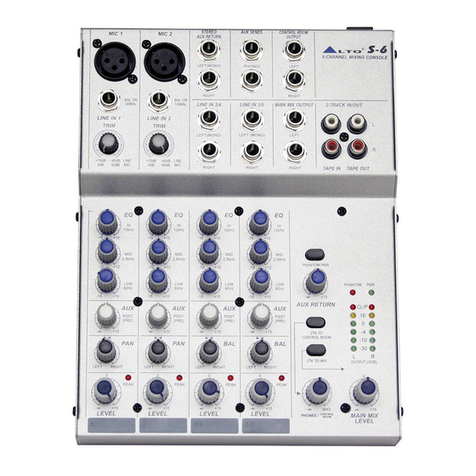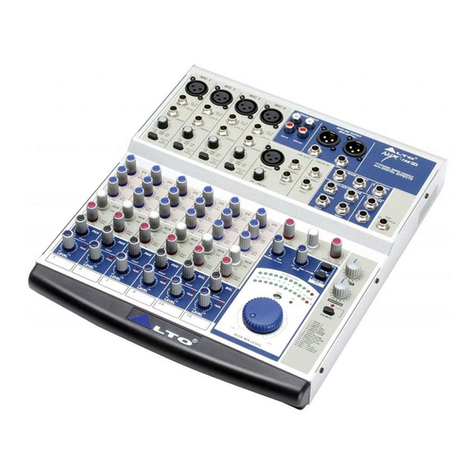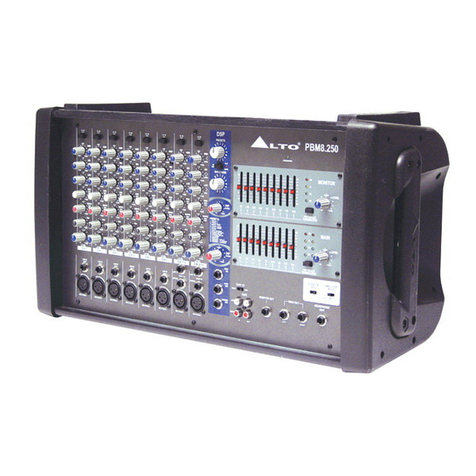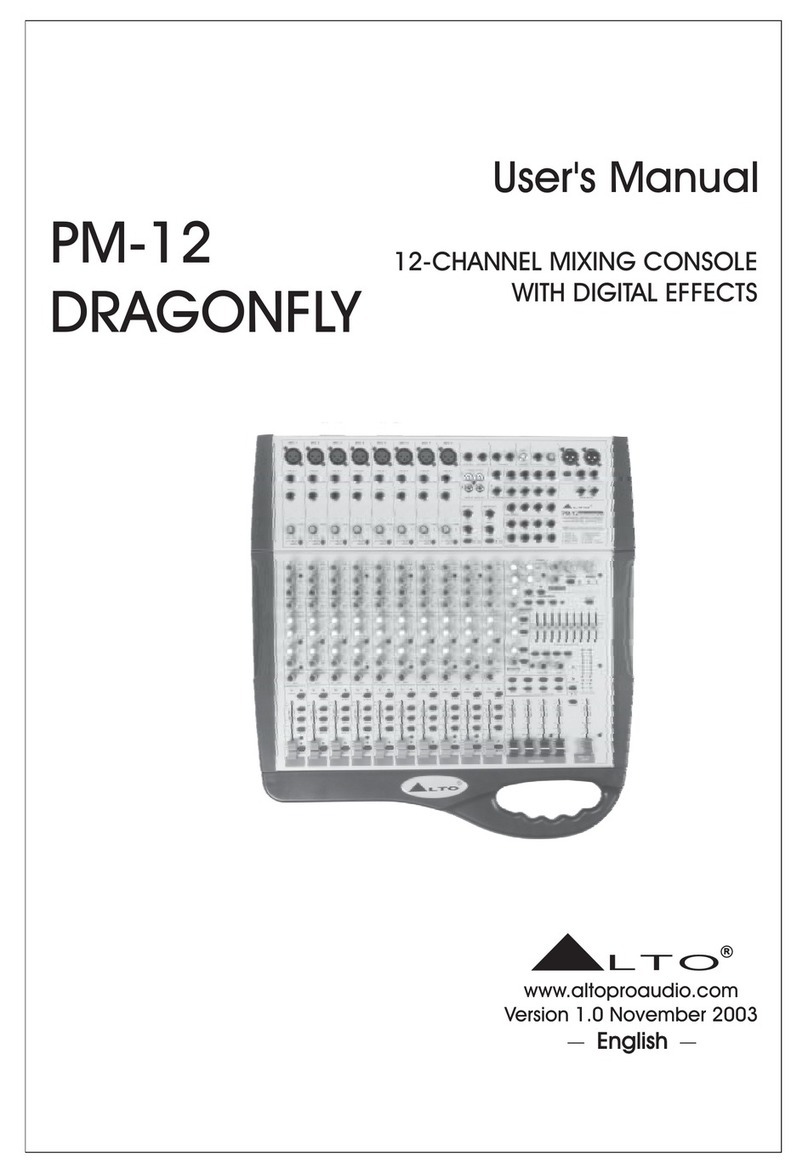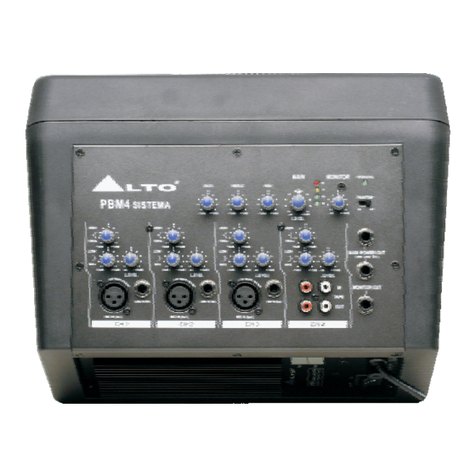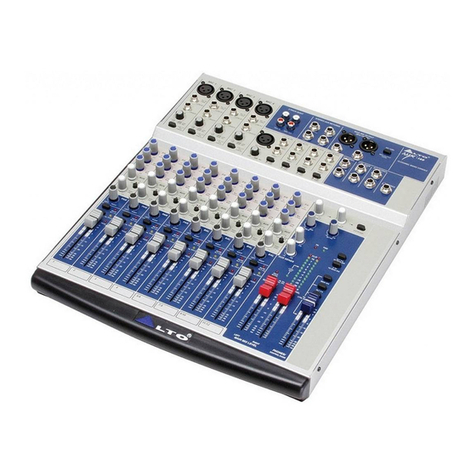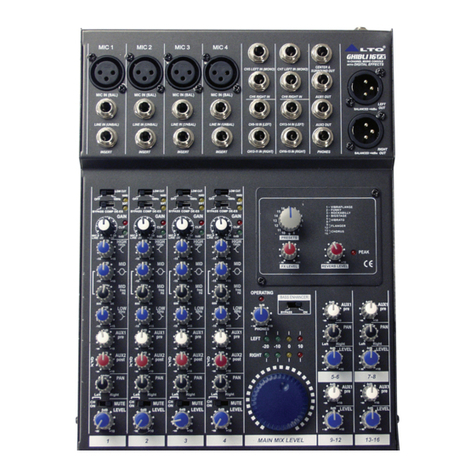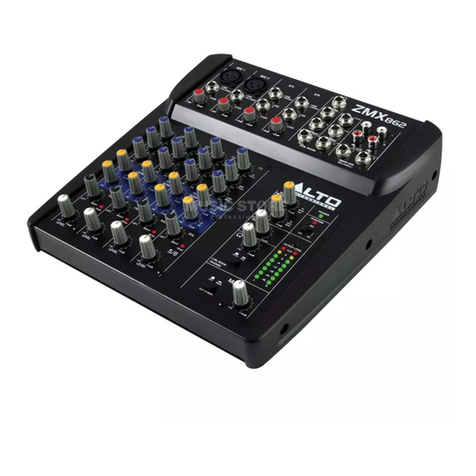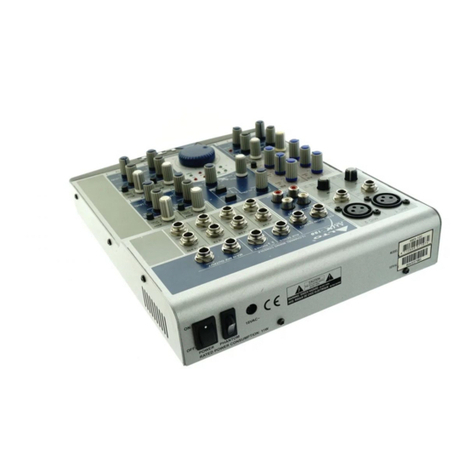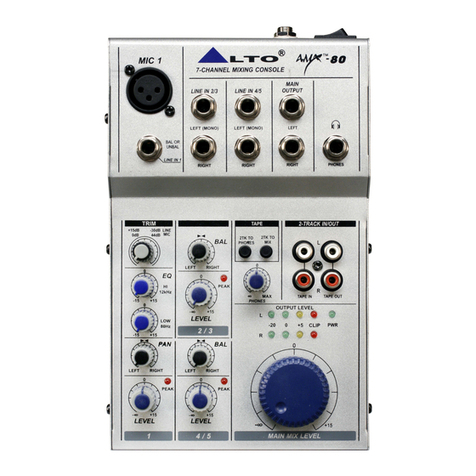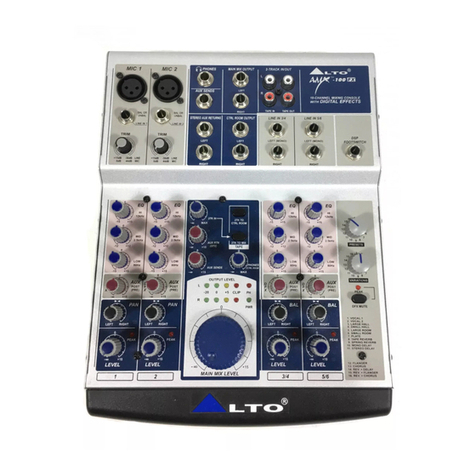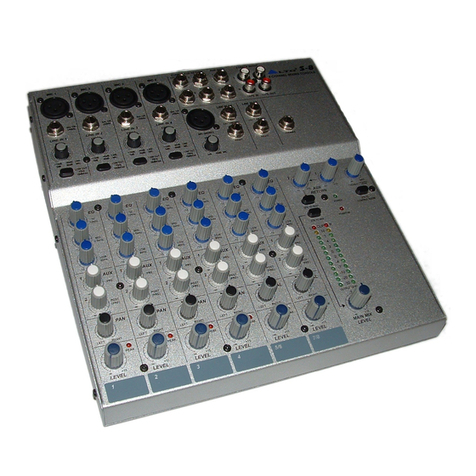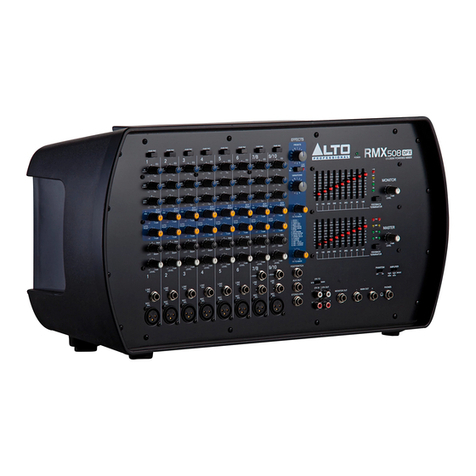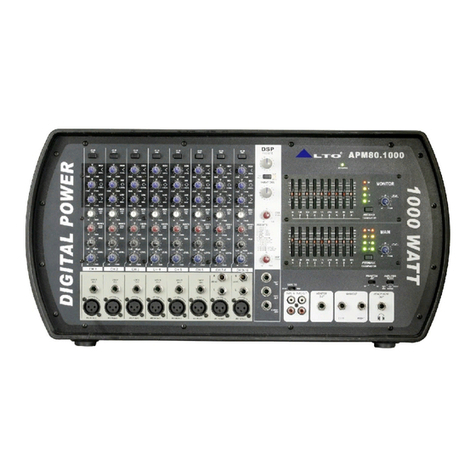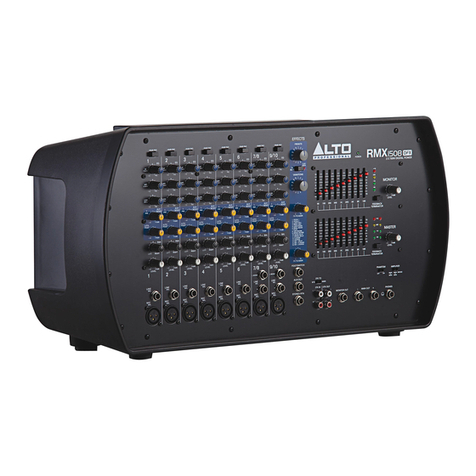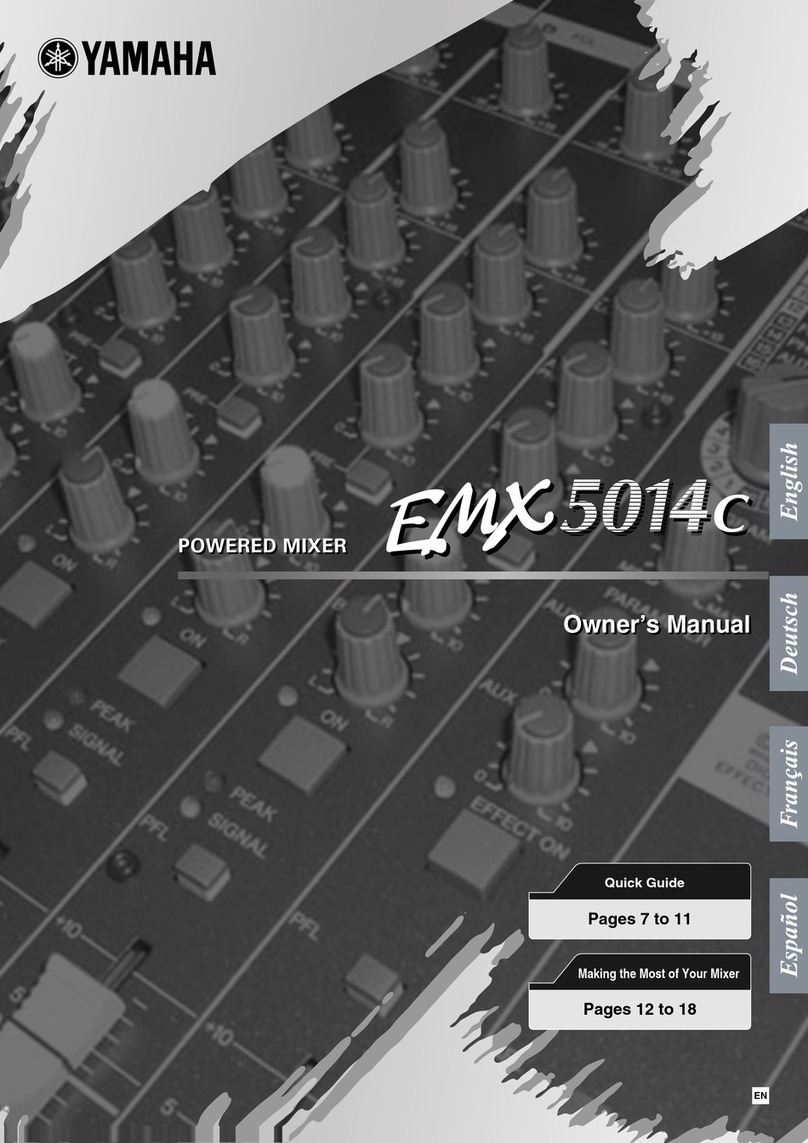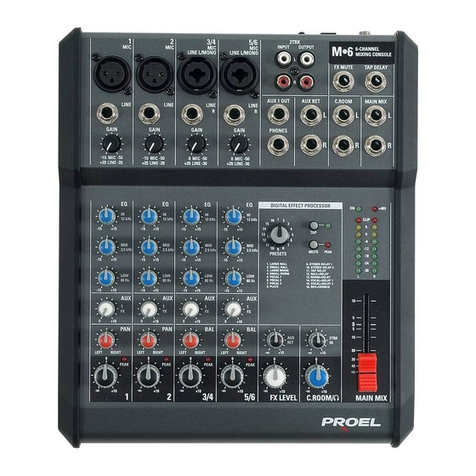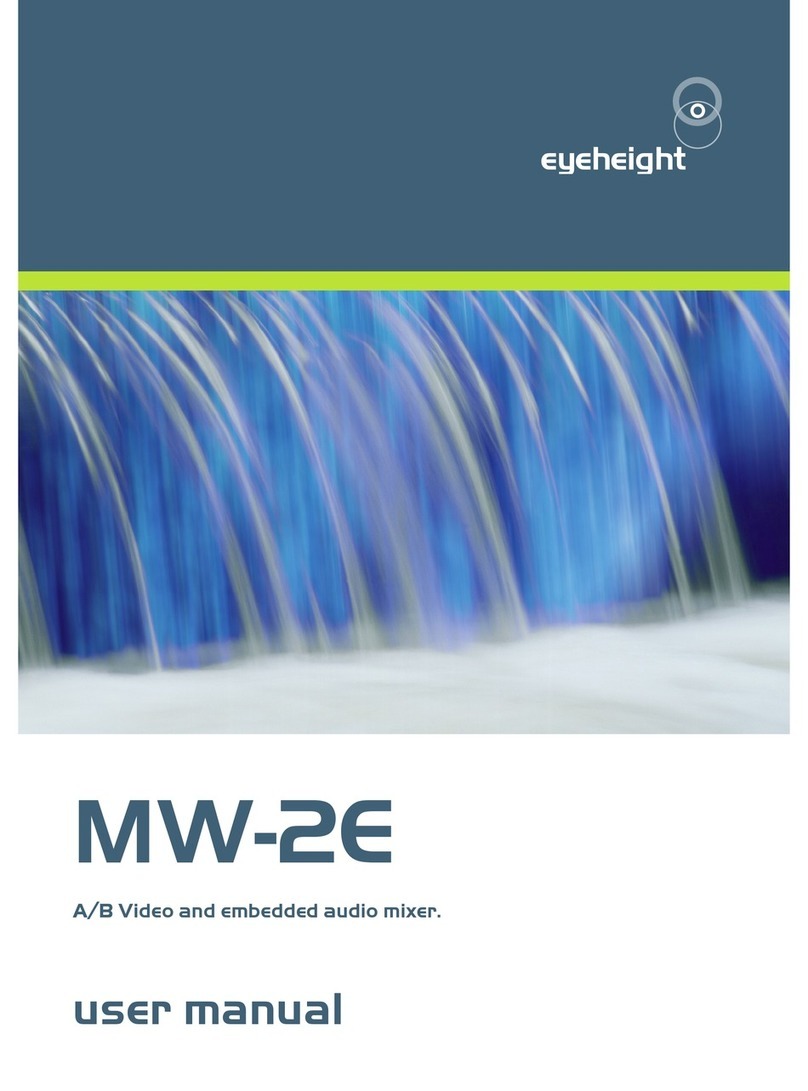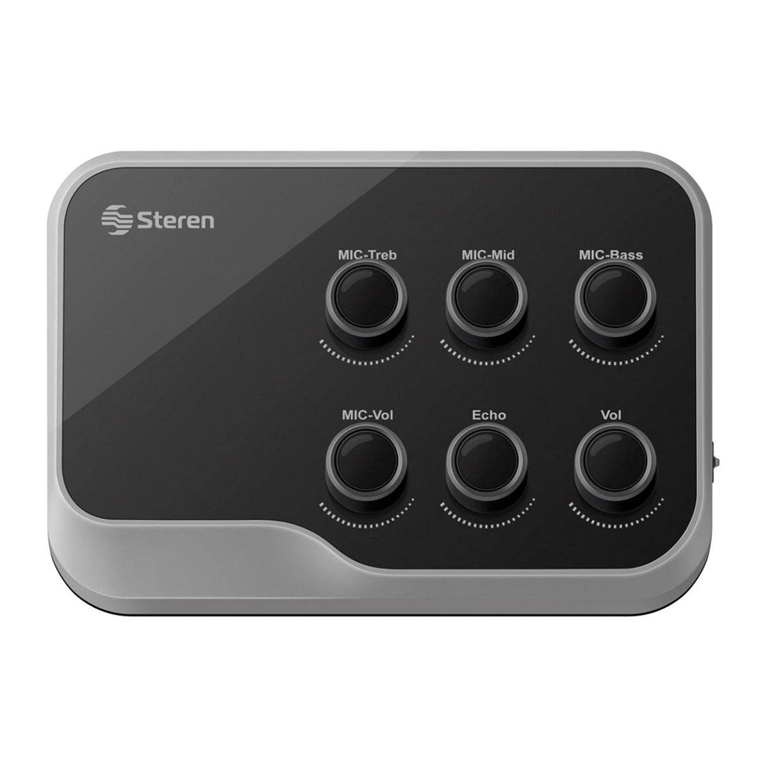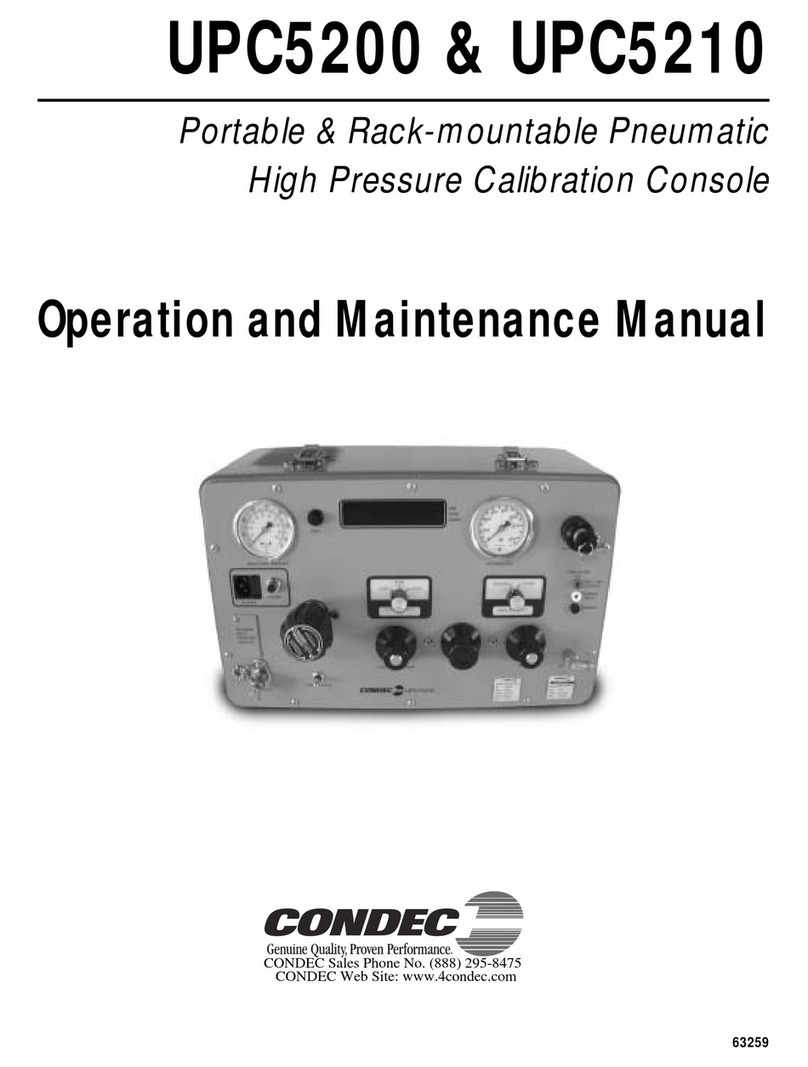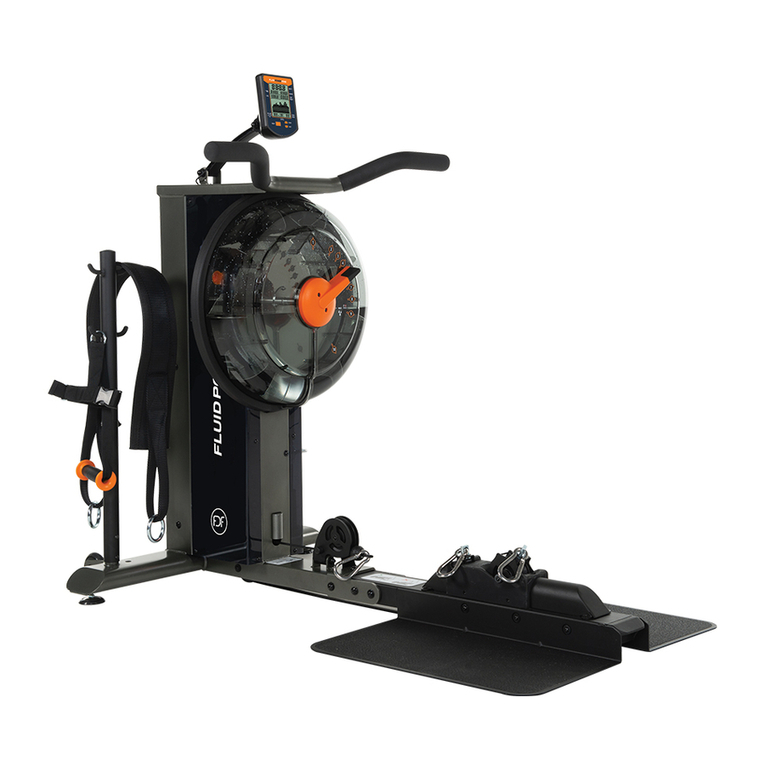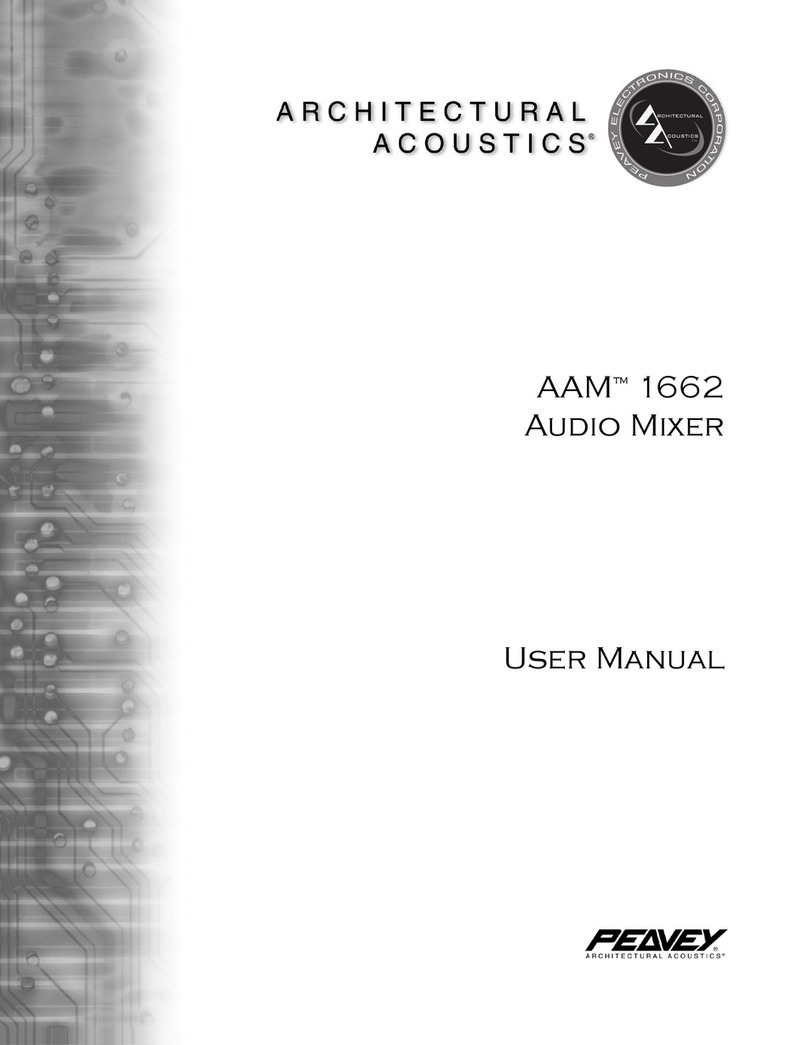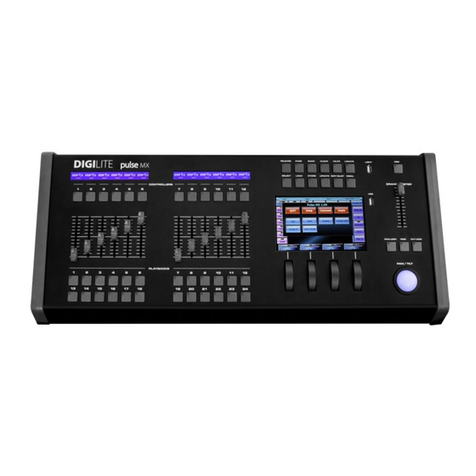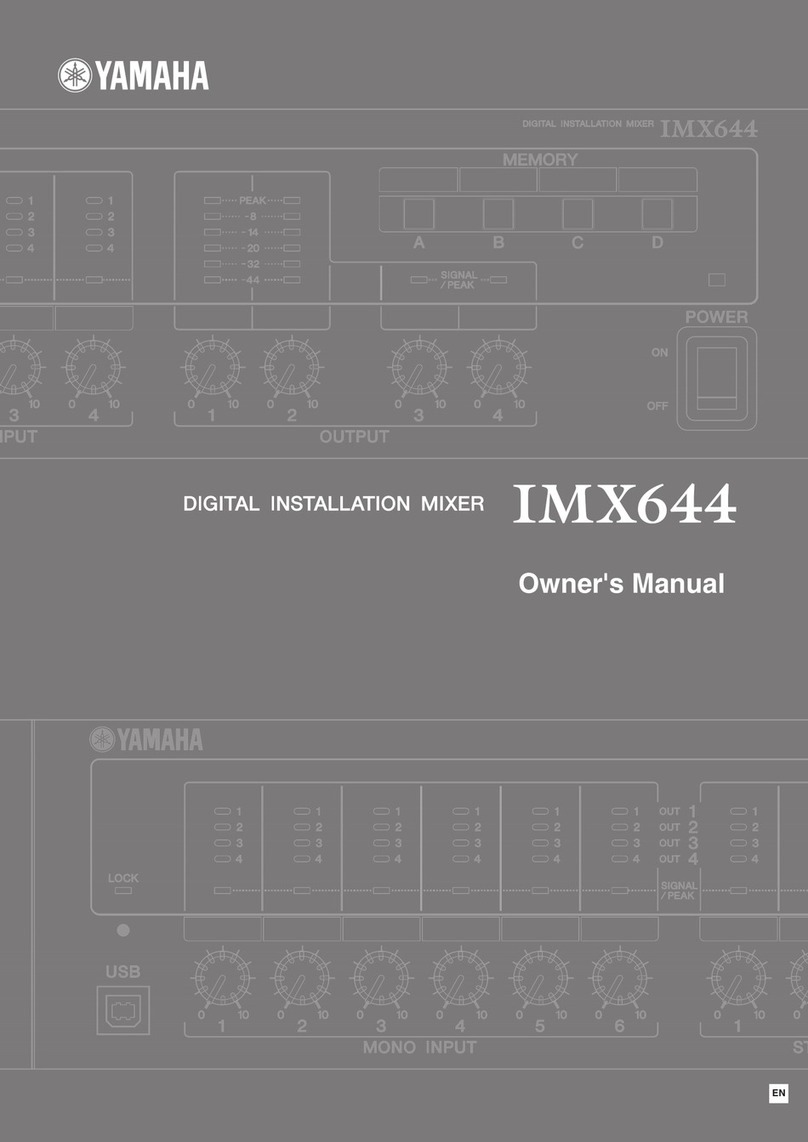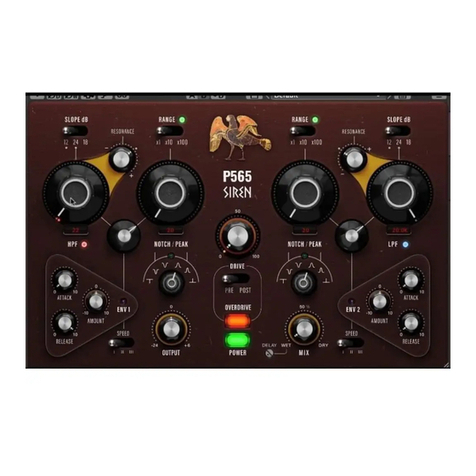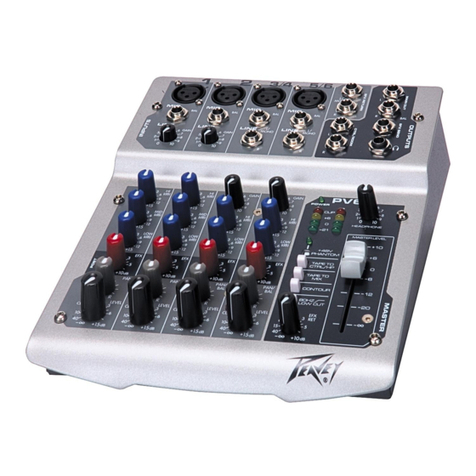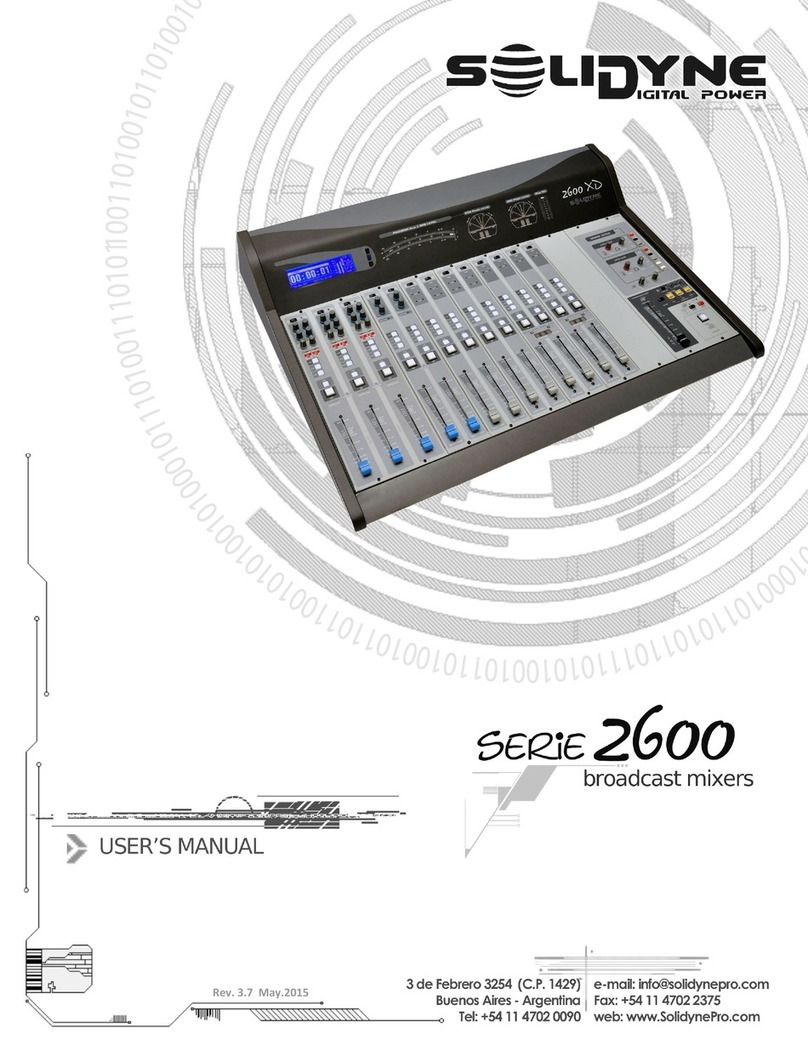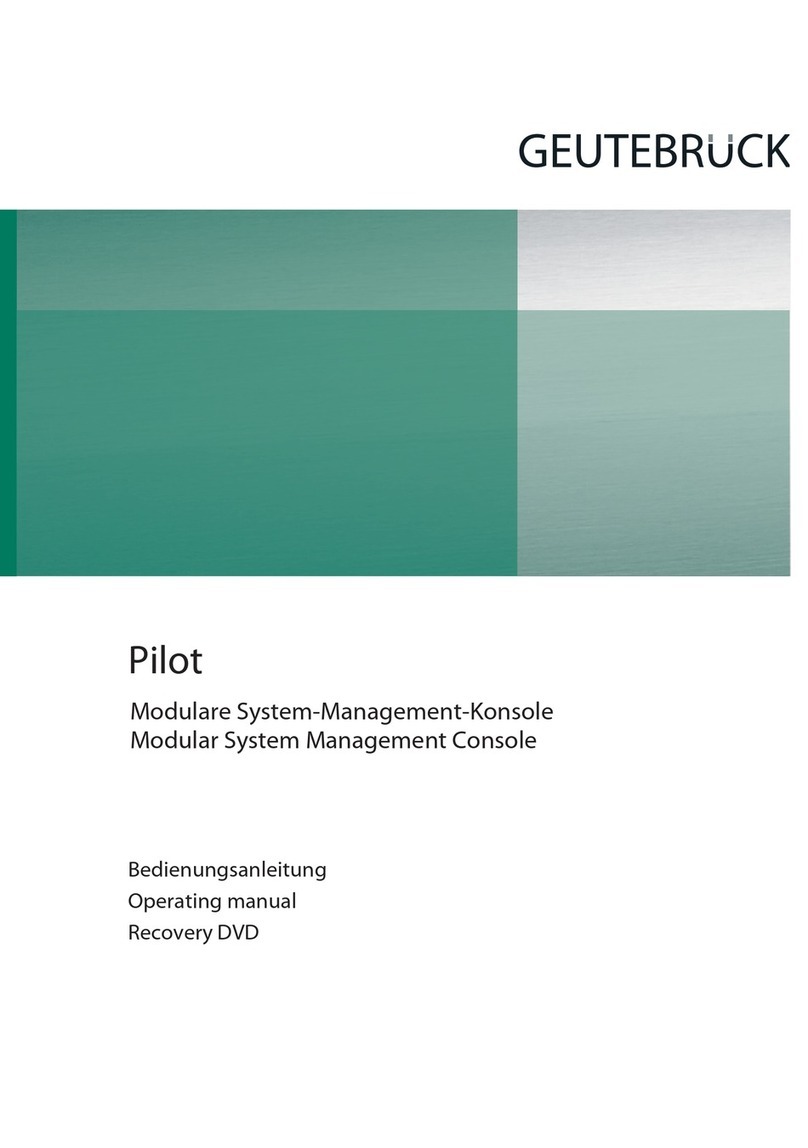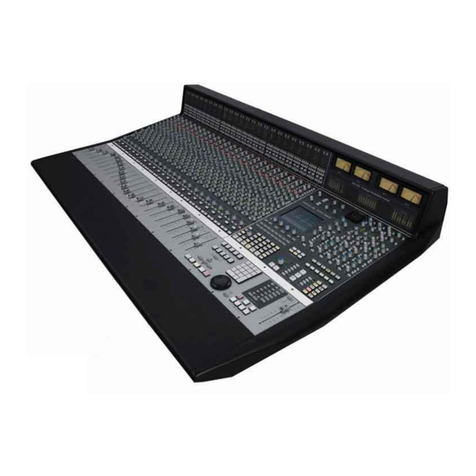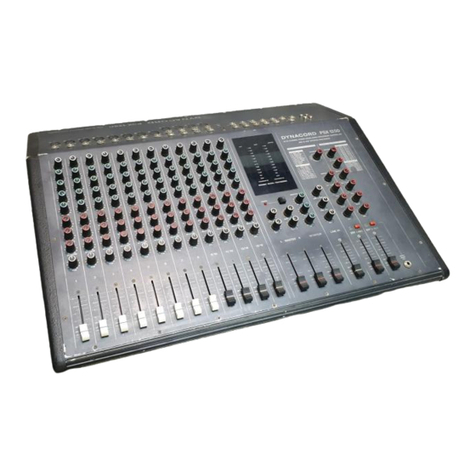Alto APM200 User manual

User's Manual
APM200
www.altoproaudio.com
Version 1.0 JUNE 2007
LTO
R
English
POWERED MIXER

CAUTION
RISK OF ELECTRIC SHOCK
DO NOT OPEN
IMPORTANT SAFETY INSTRUCTION
TO REDUCE THE RISK OF ELECTRIC SHOCK
PLEASE DO NOT REMOVE THE COVER OR
THE BACK PANEL OF THIS EQUIPMENT.
THERE ARE NO PARTS NEEDED BY USER
INSIDE THE EQUIPMENT. FOR SERVICE,
PLEASE CONTACT QUALIFIED SERVICE
CENTERS.
WARNING
To reduce the risk of electric shock
and fire, do not expose this equipment
to moisture or rain.
1.
2.
3.
4.
5.
6.
7.
8.
9.
10.
Dispose of this product should
notbeplacedinmunicipalwaste
and should be separate collection.
11.
12.
Move this Equipment only with a cart,
stand, tripod, or bracket,
specified by the
manufacturer, or
sold with the
Equipment. When
a cart is used, use
caution when
moving the cart /
equipment
combination to
avoid possible
injury from tip-over.
Permanent hearing loss may be caused by
exposure to \ extremely high noise levels.
The US. Government's Occupational Safety
and Health Administration (OSHA) has
specified the permissible exposure to noise
level.
These are shown in the following chart:
HOURS X DAY SPL EXAMPLE
According to OSHA, an exposure to high SPL in
excess of these limits may result in the loss of
heat. To avoid the potential damage of heat, it is
recommended that Personnel exposed to
equipment capable of generating high SPL use
hearing protection while such equipment is
under operation.
8
6
4
3
2
1,5
1
0,5
0,25 or less
90
92
95
97
100
102
105
110
115
Small gig
train
Subway train
High level desktop monitors
Classic music concert
Rock concert
This symbol, wherever used, alerts you to the
presence of un-insulated and dangerous voltages
within the product enclosure. These are voltages that
may be sufficient to constitute the risk of electric
shock or death.
This symbol, wherever used, alerts you to
important operating and maintenance instructions.
Please read.
Protective Ground Terminal
AC mains (Alternating Current)
Hazardous Live Terminal
ON: Denotes the product is turned on.
OFF: Denotes the product is turned off.
The apparatus shall be connected to a mains
socket outlet with a protective earthing
connection.
The mains plug or an appliance coupler is used
as the disconnect device, the disconnect device
shall remain readily operable.
CAUTION
Describes precautions that should be observed to
prevent damage to the product.
Read this Manual carefully before operation.
Keep this Manual in a safe place.
Be aware of all warnings reported
with this symbol.
Keep this Equipment away from water and
moisture.
Clean it only with dry cloth. Do not use
solvent or other chemicals.
Do not damp or cover any cooling opening.
Install the equipment only in accordance with
the Manufacturer's instructions.
Power Cords are designed for your safety. Do
not remove Ground connections! If the plug
does not fit your AC outlet, seek advice from
a qualified electrician. Protect the power
cord and plug from any physical stress to
avoid risk of electric shock. Do not place
heavy objects on the power cord. This could
cause electric shock or fire.
Unplug this equipment when unused for long
periods of time or during a storm.
Refer all service to qualified service personnel
only. Do not perform any servicing other than
those instructions contained within the
User's Manual.
To prevent fire and damage to the product,
use only the recommended fuse type as
indicated in this manual. Do not short-circuit
the fuse holder. Before replacing the fuse,
make sure that the product is OFF and
disconnected from the AC outlet.

IN THIS MANUAL:
1. INTRODUCTION................................................................................1
2. FEATURES.......................................................................................1
4. CONTROL ELEMENTS......................................................................5
5. INSTALLATION & CONNECTION......................................................15
1. INTRODUCTION
Thank you for your purchasing of the LTO APM200 20 channels power mixer with 24-bit
digital multi-effect built-in. It is just one of the many LTO products that a talented,
multinational Team of Audio Engineers and Musicians have developed with their great
passion for music. Your APM200 is a remarkable compact powered mixer that doesn't
find many equals in the market today. With 16 microphone and 2 stereo Line-level inputs
for serious live performances, your APM 200 also includes a 24 Bit digital multi-effect
with 16 Factory Presets and 16 variations for every preset, for a total of 256 different
digital effects. There is a three bands EQ on mono input channels, four bands EQ on
stereo input channels. Use it for small Gigs, for Church applications and for Conference.
Enjoy your APM200 and make sure to read this Manual carefully before operation!
2. FEATURES
16 MONO inputs with gold plated XLR and balanced TRS jacks.
2 Stereo input channels with balanced TRS jacks.
GAIN and +48V Phantom power for mono/MIC inputs.
Peak LED in each channel.
3-band EQ with sweepable MID on mono inputs.
4-band EQ on stereo inputs.
24-bit internal DSP with 256 effects, 16 presets by 16 variations with DSP
mute switch and peak LED.
9-band graphic EQ.
BNC socket for connecting gooseneck lamps.
Low cut filters 75 Hz, 18 dB/OCT. on mono inputs.
Low pass filter on mono output (80~120 Hz).
High accurate 12-segment Bar graph Meters.
Maximum Output Power(EIAJ):
A-B: 750 W+750 W/4 Ohms (1500 W bridge/8 Ohms)
C-D: 50
0 W+500 W/4 Ohms (1000 W bridge/8 Ohms)
1
7. BLOCK DIAGRAM..........................................................................21
8. TECHNICAL SPECIFICATIONS...........................................................22
9. WARRANTY..................................................................................24
3. QUICK START..................................................................................3
6. PRESET LIST.................................................................................20

2
80
100
120Hz
PFL AFL AFL AFL AFL
PFL
PEAK
PFL
PEAK
PFL
PEAK
PFL
PEAKPEAKPEAK
PFL PFL PFL
PEAK
PFL
PEAK
PEAK
PEAK
PEAK
PEAK
PEAK
PEAK
PEAK
PEAKPEAKPEAK
PFL
PFL
PFL
PFL
PFL
PFL
PFL
PFL
PFL PFL PFL
PFL
LPF
(MONOOUT)
OFF ON
AFL AFL
10
dB
5
10
20
25
30
40
60
0
5
10
dB
5
10
20
25
30
40
60
0
5
10
dB
5
10
20
25
30
40
60
0
5
10
dB
5
10
20
25
30
40
60
0
5
10
dB
5
10
20
25
30
40
60
0
5
10
dB
5
10
20
25
30
40
60
0
5
10
dB
5
10
20
25
30
40
60
0
5
10
dB
5
10
20
25
30
40
60
0
5
10
dB
5
10
20
25
30
40
60
0
5
10
dB
5
10
20
25
30
40
60
0
5
10
dB
5
10
20
25
30
40
60
0
5
10
dB
5
10
20
25
30
40
60
0
5
10
dB
5
10
20
25
30
40
60
0
5
10
dB
5
10
20
25
30
40
60
0
5
10
dB
5
10
20
25
30
40
60
0
5
10
dB
5
10
20
25
30
40
60
0
5
10
dB
5
10
20
25
30
40
60
0
5
10
dB
5
10
20
25
30
40
60
0
5
10
dB
5
10
20
25
30
40
60
0
5
10
dB
5
10
20
25
30
40
60
0
5
10
dB
5
10
20
25
30
40
60
0
5
10
dB
5
10
20
25
30
40
60
0
5
10
dB
5
10
20
25
30
40
60
0
5
10
dB
5
10
20
25
30
40
60
0
5
10
dB
5
10
20
25
30
40
60
0
5
LL
RR
TAPE OUT
2-TRACK IN/OUT
TAPE IN
CD
MAIN R
AUX2
MAIN L
AUX1
B
A
MAIN R
SUBR
MAIN L
SUBL
LR
2
4
10
20
7
30
10
CLIP
2
4
7
0
POWER
(dB)
12
16
18 20 22
24
26
28
30
6
SIG CLIP PROT
(dB)
12
16
18 20 22
24
26
28
30
6
+48V (CH 5-8) +48V (CH 13-16)
+48V (CH 9-12)
+48V (CH 1-4)
1234
BAL/UNBALBAL/UNBALBAL/UNBALBAL/UNBAL
LINEIN LINEIN LINEIN LINEIN
INSERTINSERTINSERTINSERT
5
BAL/UNBAL
LINEIN
INSERT
678910 11
BAL/UNBALBAL/UNBAL
BAL/UNBAL
BAL/UNBALBAL/UNBALBAL/UNBAL
LINEIN LINEIN LINEIN LINEIN LINEIN LINEIN
INSERTINSERTINSERTINSERTINSERTINSERT
12 13 14 15 16
BAL/UNBALBAL/UNBALBAL/UNBALBAL/UNBALBAL/UNBAL
LEFT
(MONO)
LEFT
(MONO)
RIGHT RIGHT
LINEIN LINEIN LINEIN LINEIN LINEIN
LINEIN 17LINEIN 19
LINEIN 18 LINEIN 20
INSERTINSERTINSERTINSERTINSERT
MIC 1MIC 2MIC 3MIC 4MIC 5MIC 6MIC 7MIC 8MIC 9MIC 10MIC 11MIC 12MIC 13MIC 14MIC 15MIC 16
OFF ONOFF ON
OFF ON
OFF ON
EQ OFF
EQ ON
EQ OFF
EQ ON
63 500
250
125 2K
1K 16K
8K
4K
GAIN
1
LINELINELINELINELINELINELINELINELINELINELINELINELINELINELINELINE
MIC MIC MIC MIC MIC MIC MIC MIC MIC MIC MIC MIC MIC MIC MIC MIC
dB dB dB dB dB dB dB dB dB dB dB dB dB dB dB dB dB dB
0000000000000000
LEVELSETLEVELSETLEVELSETLEVELSETLEVELSETLEVELSETLEVELSETLEVELSETLEVELSETLEVELSETLEVELSETLEVELSETLEVELSETLEVELSETLEVEL SETLEVELSETLEVEL SETLEVELSET
GAIN
2
GAIN
3
GAIN
4
GAIN
5
GAIN
6
GAIN
7
GAIN GAIN GAIN GAIN GAIN GAIN GAIN GAIN GAIN
8910 11 12 13 14 15 16 17/18 19/20
GAIN GAIN
80Hz
LOW
FREQ
MID
EQ
HI
12kHz
800
80Hz
LOW
FREQ
MID
EQ
HI
12kHz
800
80Hz
LOW
FREQ
MID
EQ
HI
12kHz
800
80Hz
LOW
FREQ
MID
EQ
HI
12kHz
800
80Hz
LOW
FREQ
MID
EQ
HI
12kHz
800
80Hz
LOW
FREQ
MID
EQ
HI
12kHz
800
80Hz
LOW
FREQ
MID
EQ
HI
12kHz
800
80Hz80Hz80Hz80Hz80Hz80Hz80Hz80Hz80Hz
LOW LOW LOW LOW LOW LOW LOW LOW LOW
FREQFREQFREQFREQFREQFREQFREQFREQFREQ
MID MID MID MID MID MID MID MID MID
EQ EQ EQ EQ EQ EQ EQ EQ EQ
HIHIHIHIHIHIHIHIHI
12kHz12kHz12kHz12kHz12kHz12kHz12kHz12kHz12kHz
800 800 800 800 800 800 800 800 800
80Hz
LOW
MID-LOW
500Hz
MID-LOW
500Hz
3kHz3kHz
HI-MID HI-MID
EQ
HI
12kHz
80Hz
LOW
EQ
HI
12kHz
20 20
(INT) (INT)
DFX2DFX2
44
11
22
33
AUXAUX
DFX1DFX1
(INT)(INT)
POSTPOST
PREPRE
POSTPOST
PREPRE
(INT)
DFX2
4
1
2
3
AUX
DFX1
(INT)
POST
PRE
POST
PRE
(INT)
DFX2
4
1
2
3
AUX
DFX1
(INT)
POST
PRE
POST
PRE
RIGHTRIGHT
LEFT LEFT
(INT)
(INT)(INT) (INT) (INT)(INT) (INT) (INT) (INT)(INT) (INT) (INT) (INT)
DFX2
DFX2DFX2 DFX2DFX2DFX2DFX2 DFX2DFX2DFX2DFX2 DFX2DFX2
4
4444444444444
PAN
RIGHT
LEFT
PAN
RIGHT
LEFT
PAN
RIGHT
LEFT
PAN
RIGHT
LEFT
PAN
RIGHT
LEFT
PAN
RIGHT
LEFT
PAN
RIGHT
LEFT
PAN
RIGHT
LEFT
PAN
RIGHT
LEFT
PAN
RIGHT
LEFT
PAN
RIGHT
LEFT
PAN
RIGHT
LEFT
PAN
RIGHT
LEFT
PAN
RIGHT
LEFT
PAN
RIGHT
LEFT
PAN
RIGHT
LEFT
1
2
ST
PFL
ST
1
11111111111111
2
22222222222222
3
3333333333333
AUX
AUX
DFX1
DFX1
(INT)
(INT)
POST
POST
PRE
PRE
POST
POST
PRE
PRE
AUX
DFX1
(INT)
POST
PRE
POST
PRE
AUXAUXAUXAUXAUXAUXAUXAUXAUX
DFX1DFX1DFX1DFX1DFX1DFX1DFX1DFX1DFX1
(INT) (INT) (INT) (INT) (INT) (INT) (INT) (INT) (INT)
POST POSTPOSTPOSTPOSTPOST POST POST POST
PREPREPREPREPREPREPREPREPRE
POST POST POSTPOSTPOSTPOST POST POST POST
PREPREPREPREPREPREPREPREPRE
AUX
DFX1
(INT)
POST
PRE
POST
PRE
AUX
(INT)
DFX2
DFX1
(INT)
POST
PRE
POST
PRE
BALBAL
1
2
AUX
PFL
1
2
AUXAUXAUX
SIG CLIP PROT
PROT
(dB)
12
16
18 20 22
24
26
28
30
6
SIG CLIP PROT
(dB)
12
16
18 20 22
24
26
28
30
6
SIG CLIP PROT
PROT
63 500
250
125 2K
1K 16K
8K
4K
PFL
ST
20 CHANNEL 1500WATT+1000 WATT POWERED MIXER WITH 24-BIT MULTI-EFFECTS PROCESSOR
LTO
R
APM200
OFF
ON
OFF
ON
BRIDGE
AMPMODE
BRIDGE
AMPMODE
15 30 45 15 30 45 15 30 45 15 30 45 15 30 45 15 30 45 15 30 45 15 30 45 15 30 45 15 30 45 15 30 45 15 30 45 15 30 45 15 30 45 15 30 45 15 30 45 20 20
15 15
100Hz8KHz
15 15
15 15
15 15
100Hz8KHz
15 15
15 15
1515
100Hz8KHz
1515
1515
1515
100Hz8KHz
1515
1515
1515
100Hz8KHz
1515
1515
1515
100Hz8KHz
1515
1515
15 15
100Hz8KHz
15 15
15 15
15 15
100Hz8KHz
15 15
15 15
1515
100Hz8KHz
1515
1515
15 15
100Hz8KHz
15 15
15 15
15 15
100Hz8KHz
15 15
15 15
15 15
100Hz8KHz
15 15
15 15
1515
100Hz8KHz
1515
1515
15 15
100Hz8KHz
15 15
15 15
15 15
100Hz8KHz
15 15
15 15
15 15
100Hz8KHz
15 15
15 15
15 15
15 15
15 15
15 15
15 15
1515
1515
1515
0
5
15
10
5
10
15
0
5
15
10
5
10
15
0
5
15
10
5
10
15
0
5
15
10
5
10
15
10
8
10
8
10
8
10
8
10
8
10
8
10
8
10
8
10
8
10
8
10
8
10
8
10
8
10
8
10
8
10
8
10
8
10
8
10
8
10
8
10
8
10
8
10
8
10
8
10
8
10
8
10
8
10
8
10
8
10
8
10
8
10
8
10
8
10
8
10
8
10
8
10
8
10
8
10
8
10
8
10
8
10
8
10
8
10
8
10
8
10
8
10
8
10
8
10
8
10
8
10
8
10
8
10
8
10
8
10
8
10
8
10
8
10
8
10
8
10
8
10
8
10
8
10
8
10
8
10
8
10
8
10
8
10
8
10
8
10
8
10
8
10
8
10
8
10
8
10
8
10
8
10
8
10
8
10
8
10
8
10
8
10
8
10
8
10
8
8888
LAMP
(12V/0.5A)
B
A
D
C
ST SUB OUT MONO OUT ST OUT
AUX 2
AUX 1
17/18
19/20
DFX1 RTN DFX2 RTN
13 14 15 16
910 11 12
2
1
3567
48
MUTE MUTE
MUTE MUTE MUTE MUTE
MUTEMUTE MUTE
MUTE
MUTE
MUTEMUTE
MUTE
MUTE MUTEMUTEMUTE
ST SUBIN
1
ST SUBIN
2
2TR IN
PHONES
LOW CUT
75Hz
18dB/Oct
LOW CUT
75Hz
18dB/Oct
LOW CUT
75Hz
18dB/Oct
LOW CUT
75Hz
18dB/Oct
LOW CUT
75Hz
18dB/Oct
LOW CUT
75Hz
18dB/Oct
LOW CUT
75Hz
18dB/Oct
LOW CUT
75Hz
18dB/Oct
LOW CUT
75Hz
18dB/Oct
LOW CUT
75Hz
18dB/Oct
LOW CUT
75Hz
18dB/Oct
LOW CUT
75Hz
18dB/Oct
LOW CUT
75Hz
18dB/Oct
LOW CUT
75Hz
18dB/Oct
LOW CUT
75Hz
18dB/Oct
LOW CUT
75Hz
18dB/Oct
ST SUBGRAPHIC EQ
STEREO GRAPHIC EQ
1. VOCAL1
2. VOCAL2
3. LARGEHALL
4. SMALL HALL
5. LARGEROOM
6. SMALL ROOM
7. PLATE
8. TAPEREVERB
9. SPRINGREVERB
10. MONODELAY
11. STEREO DELAY
12. FLANGER
13. CHORUS
14. REV.+DELAY
15. REV.+FLANGER
16. REV.+CHORUS
PRESETS
10 8
9
1
12
11 7
4
5
6
3
2
13
14
15 16
VARIATIONS
DFX MUTE
PEAK
10 8
9
1
12
11 7
4
5
6
3
2
13
14
15 16
1. VOCAL 1
2. VOCAL 2
3. LARGEHALL
4. SMALL HALL
5. LARGEROOM
6. SMALL ROOM
7. PLATE
8. TAPE REVERB
9. SPRINGREVERB
10. MONODELAY
11. STEREO DELAY
12. FLANGER
13. CHORUS
14. REV. + DELAY
15. REV. + FLANGER
16. REV. + CHORUS
PRESETS
10 8
9
1
12
11 7
4
5
6
3
2
13
14
15 16
VARIATIONS
DFX MUTE
PEAK
10 8
9
1
12
11 7
4
5
6
3
2
13
14
15 16
POWER AMPC-D (500WX2)
POWER AMPA-B (750WX2)
FOOT SW
2
PHONES
FOOTSW
1
MONOOUT
L
R
ST SUBOUT
A
B
P. AMP INPUT
ST SUBIN
2
ST SUBIN
1
R
(MONO)
L
(MONO)
L
R
C
D
P. AMP INPUT
PHANTOM
PHANTOMPHANTOM
PHANTOM
AUX SEND
1
AUXSEND
2
DFX1 SEND
DFX2SEND
ST OUT
L
R

This is the fastest way to get something out from your APM200, if you have a keyboard
and a microphone.
a. Plug the microphone into Channel 1 MIC IN.
b. Turn down AUX and LEVEL controls on the input channel.
c. Put the EQ controls on center position.
d. Connect 2 passive cabinets to the rear speaker cabinets.
e. Turn on your APM200.
g.Ifyoulike,youcanaddsomeequalizationatthisstage.
h. The LED on the Master LED meter should flash only occasionally, otherwise you will hear
distortion. If this LED is not active and you still hear distortion, please turn down a little
the input LEVEL control or reduce the output level of your source instrument.
i. Connect your stereo keyboard into channel 17/18 and repeat the sequence..
Here you are. It is your first gig with your APM200.
f. Sing or speak into the microphone with normal volume and adjust the channel LEVEL
control of half.
3
3. QUICK START

4
LL
RR
TAPE OUT
2-TRACK IN/OUT
TAPE IN
CD
MAIN R
AUX 2
MAIN L
AUX 1
BA
MAIN R
SUB R
MAIN L
SUB L
+48V (CH 5-8) +48V (CH 13-16)+48V (CH 9-12)
+48V (CH 1-4)
1234
BAL/UNBAL BAL/UNBAL BAL/UNBAL BAL/UNBAL
LINE IN LINE IN LINE IN LINE IN
INSERT INSERT INSERT INSERT
5
BAL/UNBAL
LINE IN
INSERT
678 91011
BAL/UNBAL BAL/UNBAL
BAL/UNBAL
BAL/UNBAL BAL/UNBAL BAL/UNBAL
LINE IN LINE IN LINE IN LINE IN LINE IN LINE IN
INSERT INSERT INSERT INSERT INSERT INSERT
12 13 14 15 16
BAL/UNBAL BAL/UNBAL BAL/UNBAL BAL/UNBAL BAL/UNBAL
LEFT
(MONO)
LEFT
(MONO)
RIGHT RIGHT
LINE IN LINE IN LINE IN LINE IN LINE IN
LINE IN 17 LINE IN 19
LINE IN 18 LINE IN 20
INSERT INSERT INSERT INSERT INSERT
MIC 1 MIC 2 MIC 3 MIC 4 MIC 5 MIC 6 MIC 7 MIC 8 MIC 9 MIC 10 MIC 11 MIC 12 MIC 13 MIC 14 MIC 15 MIC 16
OFF ON OFF ONOFF ONOFF ON
20 CHANNEL 1500WATT+1000 WATT POWERED MIXER WITH 24-BIT MULTI-EFFECTS PROCESSOR
LTO
RAPM200
OFF
ON
OFF
ON
BRIDGE
AMP MODE
BRIDGE
AMP MODE
LAMP
(12V/0.5A)
POWER AMP C-D (500WX2)
POWER AMP A-B (750WX2)
FOOT SW2
PHONES
FOOT SW
1
MONO OUT
L
R
ST SUB OUT
A
B
P. AMP INPUT
ST SUB IN2
ST SUB IN1
R
(MONO)
L
(MONO)
L
R
C
D
P. AMP INPUT
PHANTOM
PHANTOM PHANTOMPHANTOM
AUX SEND1
AUX SEND2
DFX1 SEND
DFX2 SEND
ST OUT
L
R
DRUM MACHINE
KEYBOARD
BASS HEADPHONEGUITAR
D/I BOX
HOOK
UP
COMPUTER SET-UP DIAGRAM
HOOK
UP
SMALL GIG HOOKUP DIAGRAM
A C T I V E SPEAKERS
CD PLAYER 1
WIRELESS
MICROPHONE
MIC1
MIC2
MIC3
MIC4
MIC5
MIC6
LL
RR
TAPE OUT
2-TRACK IN/OUT
TAPE IN
CD
MAIN R
AUX 2
MAIN L
AUX 1
BA
MAIN R
SUB R
MAIN L
SUB L
+48V (CH 5-8) +48V (CH 13-16)+48V (CH 9-12)
+48V (CH 1-4)
1234
BAL/UNBAL BAL/UNBAL BAL/UNBAL BAL/UNBAL
LINE IN LINE IN LINE IN LINE IN
INSERT INSERT INSERT INSERT
5
BAL/UNBAL
LINE IN
INSERT
678 91011
BAL/UNBAL BAL/UNBAL
BAL/UNBAL
BAL/UNBAL BAL/UNBAL BAL/UNBAL
LINE IN LINE IN LINE IN LINE IN LINE IN LINE IN
INSERT INSERT INSERT INSERT INSERT INSERT
12 13 14 15 16
BAL/UNBAL BAL/UNBAL BAL/UNBAL BAL/UNBAL BAL/UNBAL
LEFT
(MONO)
LEFT
(MONO)
RIGHT RIGHT
LINE IN LINE IN LINE IN LINE IN LINE IN
LINE IN 17 LINE IN 19
LINE IN 18 LINE IN 20
INSERT INSERT INSERT INSERT INSERT
MIC 1 MIC 2 MIC 3 MIC 4 MIC 5 MIC 6 MIC 7 MIC 8 MIC 9 MIC 10 MIC 11 MIC 12 MIC 13 MIC 14 MIC 15 MIC 16
OFF ON OFF ONOFF ONOFF ON
20 CHANNEL 1500WATT+1000 WATT POWERED MIXER WITH 24-BIT MULTI-EFFECTS PROCESSOR
LTO
RAPM200
OFF
ON
OFF
ON
BRIDGE
AMP MODE
BRIDGE
AMP MODE
LAMP
(12V/0.5A)
POWER AMP C-D (500WX2)
POWER AMP A-B (750WX2)
FOOT SW2
PHONES
FOOT SW
1
MONO OUT
L
R
ST SUB OUT
A
B
P. AMP INPUT
ST SUB IN2
ST SUB IN1
R
(MONO)
L
(MONO)
L
R
C
D
P. AMP INPUT
PHANTOM
PHANTOM PHANTOMPHANTOM
AUX SEND1
AUX SEND2
DFX1 SEND
DFX2 SEND
ST OUT
L
R
DRUM MACHINE
KEYBOARD
BASS HEADPHONEGUITAR
D/I BOX
CD PLAYER 1
WIRELESS
MICROPHONE
MIC1
MIC2
MIC3
MIC4
MIC5
MIC6
SOUND CARD
LINE
IN
LINE
OUT
MIC
IN
STAGE MONITORS
STAGE MONITORS

5
4 +48 Volt Phantom Power and LED
It is available only to the XLR MIC sockets. Never plug
in a microphone when phantom power is already on.
Before turning phantom power on, make sure that all
faders are totally down. In this way you will protect
your stage monitors and main loudspeakers. If this switch
activated, the LED next to the button will light up.
Mono and Stereo Input Channels
LEFT
(MONO)
RIGHT
LINE IN 17
LINE IN 18
1
BAL/UNBAL
LINE IN
INSERT
MIC 1
SPOTLIGHT
4. CONTROL ELEMENTS
1 The MONO MIC/LINE Channels
This is where you connect external sound processors such
as compressor-limiter, equalizers, etc. The insert point is
available on the first 16 MIC channels only. For the other
channels you can always insert the processor in between
the sound source ( such as keyboard or drum machine )
and the APM input. The Insert sockets can be used as
direct-outs to feed the input of a 4-track tape recorder.
These are Channel 17/18 and 19/20. They are organised
in stereo pair and provided with 1/4" TRS phone sockets.
If you connect only the left jack, the input will operate in
mono mode, that is the mono signal will appear on both
input channels. You can use these inputs with a stereo
keyboard, drum machine, etc.
1
2
3
2 MONO Channel INSERT
3 STEREO INPUTS
+48V (CH 1-4)
OFF ON
PHANTOM
4
Your APM200 is equipped with 16 low-noise microphone preamplifiers with
optional phantom power, 45dB of Gain and over 115dB of S/N ratio. You can
connect almost any type of microphone. Dynamic microphones do not need
phantom power. Use phantom power only with condenser microphones but
make sure that the phantom power button is disengaged before connecting
the microphone. Phantom power will not damage your dynamic microphones,
so make sure to read the microphone instructions manual before engaging
phantom power. Use switch (4) to activate/deactivate phantom power. These
channels are also equipped with 1/4" TRS balanced/unbalanced LINE-IN plugs
to connect line-level instruments such as keyboards, drum machines and
effect devices.

SPOTLIGHT
4. CONTROL ELEMENTS
6
By pressing this button, you will activate a 75 Hz
low frequency filter with a slope of 18 dB per octave.
You can use this facility to reduce the hum noise
infected by the mains power supply, or the stage
rumble while using a microphone.
This control is provided with 2 different indications: One is for the MIC and the
other for LINE levels. When you use a microphone, you shall read the MIC ring
(0~-45dB); when you use a line level instrument, you shall read the LINE ring
(+15~-30dB). For optimum operation you shall set this control in a way that
the PEAK LED(18) blinks only occasionally in order to avoid distortion on the
input channel.
When you use a line level instrument, you shall read the ring (+20~-20 dB).For
optimum operation you shall set this control in a way that the PEAK LED(18)
blinks only occasionally in order to avoid distortion on the input channel.
This LED will help you to detect the input level
immediately. In this case the research of the
fault will become much faster!
dB
LEVEL SET
17/18
GAIN
20 20
GAIN
1
LINE
MIC
dB
0
LEVEL SET
15 30 45
LOW CUT
75Hz
18dB/Oct
EQUALISER
There are 1-16: HI, MID
and LOW band. There are the stereo channel17-20:
HI, HI-MID, MID-LOW and LOW band. All bands provide up to 15dB of boost or cut.
3 bands EQ with sweepable MID on all mono input channel
4 bands fixed frequency EQ on
5
7
6
5 MONO IN GAIN
6 LEVEL SET LED
7 LOW-CUT Button
6
8
8 STEREO IN GAIN
9
10
13
80Hz
LOW
FREQ
MID
EQ
HI
12kHz
800
15 15
100Hz 8KHz
15 15
15 15
11
12
13
9
80Hz
LOW
MID-LOW
500Hz
3kHz
HI-MID
EQ
HI
12kHz
15 15
15 15
15 15
15 15

7
This is a peaking filter and it will boost/cut frequencies from 100Hz to 8kHz
depending on the position of the MID freq control. This control will affect
especially upper male and lower female vocal ranges and also the harmonics
of most musical instruments.
10 MID
9HI
16
14
15
11 HI-MID
This control gives you up to 15 dB boost/cut at 3 kHz. It is useful for controlling
voice. It can accurately polish your performance via adjusting this knob.
12 MID-LOW
This control gives you up to 15 dB boost or cut at 500 Hz.
13 LOW
If you turn this control up, you will boost all frequencies below 80 Hz. You will give
more punch to bass drum and bass guitar and make the vocalist more "macho".
Turn it down, you will cut all the frequencies below 80 Hz. In this way you can avoid
low-frequency vibrations and resonance thus preserving the life of your woofers.
SPOTLIGHT
4. CONTROL ELEMENTS
14 AUX SENDS Level Control
These four controls are used to adjust the
level of the respective signal sent to AUX
bus, AUX1 and AUX2 can be switched to
PRE/POST-FADER via the PRE/POST button.
so, generally, they can be used for monitor
application and effects & sound processors
Input. AUX3 and AUX4 are configured as
POST-Faders. In this typical compact unit,
excluding sending out the signal directly to
the external effect or processor equipment,
they can also be assigned to the internal
onboard effect module.
RIGHT
LEFT
(INT) (INT)
DFX2 DFX2
44
PAN
RIGHT
LEFT
11
22
33
AUX
DFX1
(INT)
POST
PRE
POST
PRE
AUX
DFX1
(INT)
POST
PRE
POST
PRE
BAL
10
8
10
8
10
8
10
8
10
8
10
8
10
8
10
8
MUTEMUTE
If you turn this control up, you will boost all the frequencies above 12 kHz (shelving
filter). You will add transparency to vocals and guitar and also make cymbals crispier.
Turn the control down to cut all frequencies above 12 kHz. In such way you can reduce
sibilances of human voice or reduce the hiss of a Tape player.

8
- TAPE IN
Use the Tape input if you wish to listen to your mix from
a Tape Recorder or DAT.
- TAPE OUT
These RCA jacks will route the main mix into a tape recorder.
Each channel is equipped with the MUTE switch. Pressing this switch is equal
to turning the fader down, which can mute the corresponding channel output
except for the PRE AUX sends, channel INSERT send.
Abbreviation of PANORAMA control for mono channels, or the stereo channels,
always says, BALANCE control. Keep this control in center position, then the
signal will be positioned in the middle of stage.
Master Section
Inside your APM Series the audio signal is monitored in
several different stages and then sent to the PEAK LED.
When the LED is red illuminated, it warns you that you
are reaching signal saturation and possible distortion, then
you should reduce the input level for avoiding distortion.
18 PEAK LED
Each channel has a PFL switch which will send a signal from a post-EQ pre-fader
location to the PHONES jack. Use this when you wish to use the headphones to
monitor only a specific channel. Moreover, you can monitor a channel no matter
the channel is lowered or the MUTE switch is on when this PFL switch is engaged.
This will not affect the signals that are sent to the ST bus and AUX buses.
17 PFL (pre-fader listen) Switch
SPOTLIGHT
4. CONTROL ELEMENTS
19 FADER
This fader will adjust the overall level of this channel
and set the amount of signal sent to the main output.
15 PAN/BAL Control
16 MUTE Switch
20 2-TRACK IN/OUT
LL
RR
TAPE OUT
2-TRACK IN/OUT
TAPE IN
20
17
18
19
PEAK
PFL
10
dB
5
10
20
25
30
40
60
0
5
1

22 P. AMP INPUT Jacks
These 1/4" phone jacks are used to input line level stereo signals to the built-in
power amplifier.
These 1/4" phone jacks are used to send out the signal from the AUX bus to external
devices such as effect units and/or stage monitors.
2824
21
22 29
26
27
SPOTLIGHT
4. CONTROL ELEMENTS
9
23 ST OUT Jacks
These jacks are used to output the signal of the STEREO bus. The final output
level from these jacks is adjusted by the ST OUT fader.
25 ST SUB OUT Jacks
These jacks are used to output the signal of the STEREO bus. Use the ST SUB
OUT control to adjust the final output level at the ST SUB OUT jacks. Generally,
it is available to connecting effects unit.
26 MONO OUTPUT Jack
Use this balanced MONO jack to connect the input of an external amplifier or
active monitor speaker.
27 FOOTSWITCH Jack
This 1/4" jack can be used to connect an external foot switch to turn on/off the
onboard effect module.
24STSUBIN1&2Jacks
These 1/4" jacks are used to connect stereo output of a sub mixer or external effect
processor. The signal input can be routed to the AUX1 & 2 bus and STEREO bus.
21 AUX / DFX SENDS Connectors
LAMP
(12V/0.5A)
LAMP
(12V/0.5A)
FOOT SW2FOOT SW2
PHONES
FOOT SW
1
FOOT SW
1
MONO OUTMONO OUT
L
R
ST SUB OUTST SUB OUT
A
B
P. AMP INPUTP. AMP INPUT
ST SUB IN2ST SUB IN2
ST SUB IN1ST SUB IN1
R
(MONO)
L
(MONO)
L
R
C
D
P. AMP INPUTP. AMP INPUT
AUX SEND1AUX SEND1
AUX SEND2AUX SEND2
DFX1 SENDDFX1 SEND
DFX2 SENDDFX2 SEND
ST OUTST OUT
L
R
23
25

SPOTLIGHT
4. CONTROL ELEMENTS
10
This jack will be used to send the signal to a headphone or to a pair of powered
studio monitors.
29 LAMP
This lovable LAMP is very convenient for your operation, it is located in the top
right corner of the front panel, and provides the 12V socket that can drive
standard BNC-type lamp.
This control is used to adjust the level of PHONES
output, which can be varied from - to +10.
The ST knob is used to adjust the amount of stereo
signal sent from the ST SUB IN1-2 jacks to the
STEREO bus.
32 PHONES Control
These knobs are used to adjust the amount of the
signal sent from the ST SUB IN1-2 jacks to the
AUX1-2 buses.
35 AUX1-2 Controls
36 ST (stereo ) Control
37 PFL (pre-fader listen) Switch
When this switch is engaged, the signal at the point before the ST control
knob is sent to the PHONES jack.
28 PHONES Jack
30
32
34
37
35
36
33 ST (stereo) Control
This knob is used to adjust the level of the signal sent from the 2TR IN jacks
to the STEREO bus. The adjustable range goes from - to +10dB.
34 PFL Switch
When this switch is engaged, the signal input from the 2TR IN jacks is routed
at the point before the ST control to the PHONES jack.
The LED indicates when the power is switched on.
31 POWER LED 31
33
The stereo LED meter will indicate the signal level sent to ST OUT outputs.
30 LED METER Display
1
2
ST
PFL
ST
1
2
PFL
AUX AUX
10
8
10
8
10
8
10
8
10
8
10
8
ST SUB IN 1ST SUB IN 2
LR
2
4
10
20
7
30
10
CLIP
2
4
7
0
POWER
PFL
ST
10
8
10
8
2TR IN
PHONES

SPOTLIGHT
4. CONTROL ELEMENTS
38 LPF (MONO OUT)
This switch applies a low-pass filter to the signal that is output from the
STEREO bus.
You can adjust the frequency to the desired position by using a screwdriver
to turn the control. The output region will below the frequency (80-120 Hz) if
you specify by the control. Use it when you are using a sub-woofer.
40 AFL Switch
When this switch is on, the output signal that passes through the corresponding
fader is sent to the PHONE jack.
11
- LPF ON/OFF Switch
- LPF Control
39 PFL Switch
When this switch is on, the signal at the point before the ST OUT control fader
is sent to the PHONE jack.
42 MONO OUT Fader
The MONO OUT fader adjusts the final level of the signal output from the
STEREO bus to the MONO OUT jack.
41 ST OUT Fader
The ST OUT fader adjusts the final level of the signal sent from the STEREO
bus to the ST OUT jacks.
44 AUX1-2 Fader
The AUX1-2 faders adjust the final level
of the signal sent from the AUX1-2 bus
to the AUX SEND1-2 jacks.
These faders are used to adjust the level
of the return signal which is sent from
the built-in DSP to the STEREO bus.
45 DFX1 & DFX2 RTN Fader
This fader adjusts the final level of the
signal sent from the ST bus to the ST
SUB OUT jacks.
43 ST SUB OUT Fader
44 42 41
39
38
43
45
80
100
120Hz
PFL AFL AFL AFL AFLPFL
PFL
LPF
(MONO OUT)
OFF ON
AFL AFL
10
dB
5
10
20
25
30
40
60
0
5
10
dB
5
10
20
25
30
40
60
0
5
10
dB
5
10
20
25
30
40
60
0
5
10
dB
5
10
20
25
30
40
60
0
5
10
dB
5
10
20
25
30
40
60
0
5
10
dB
5
10
20
25
30
40
60
0
5
10
dB
5
10
20
25
30
40
60
0
5
ST SUB OUT MONO OUT ST OUT
AUX 2
AUX 1
DFX1 RTN DFX2 RTN
40

SPOTLIGHT
4. CONTROL ELEMENTS
12
Each one of these faders will boost or attenuate (+/-15dB) the selected frequency
at a preset bandwidth. When all the faders are in the centre position, the output
of the equalizer is flat response.
46 STEREO EQ Switch
Engage this button to add the stereo graphic EQ into the main mix output circuit.
It can be used to modify the frequency "contour" of a sound. If you release the
button free, the stereo graphic EQ will be bypassed.
51 POWER AMP. MODE Switch
This switch provides three modes:
A-B: MAIN L/MAIN R; SUB L/SUB R; BRIDGE.
C-D:
Select any one of these modes to specify the signals to be routed to the
corresponding jacks according to the speaker connection at speaker jacks on
the rear panel. The details refer to later content.
MAIN L/MAIN R; AUX1/AUX2; BRIDGE.
47 STEREO GRAPHIC EQ
Each one of these faders will boost or attenuate (+/-15dB) the selected frequency
at a preset bandwidth. When all the faders are in the centre position, the output
of the equalizer is flat response.
48 ST SUB EQ Switch
Engage this button to add the stereo graphic EQ into the ST SUB output circuit.
It can be used to modify the frequency "contour" of a sound. If you release the
button free, the ST SUB graphic EQ will be bypassed.
49 ST SUB GRAPHIC EQ
CD
MAIN R
AUX 2
MAIN L
AUX 1
B
A
MAIN R
SUB R
MAIN L
SUB L
OFF
ON
OFF
ON
BRIDGE
AMP MODE
BRIDGE
AMP MODE
POWER AMP C-D (500WX2)
POWER AMP A-B (750WX2)
EQ OFF
EQ ON
63 500250125 2K
1K 16K
8K4K
0
5
15
10
5
10
15
0
5
15
10
5
10
15
ST SUB GRAPHIC EQ
49
51
50
EQ OFF
EQ ON
63 500250125 2K
1K 16K
8K4K
0
5
15
10
5
10
15
0
5
15
10
5
10
15
STEREO GRAPHIC EQ
48
47
46
50 POWER AMP Switch
This switch is used to control the amplifier input signal.

58 DFX MUTE Switch & PEAK LED
This switch is used to activate/deactivate the effect
facility. This LED lights up when the input signal is too
strong. In case of the digital effect module being muted,
this LED also lights up.
SPOTLIGHT
4. CONTROL ELEMENTS
There is a powerful 24-bit/256 preset digital multi-effects included in your APM Series
Effects include reverbs, chorus, flanger, delay and combinations of the above.
DSP SECTION
Adjust this knob to select the right effect you wish to
perform. There are total 16 options for you: several
kinds of reverb, mono and stereo delay, effects with
modulation, and versatile two-effect combination.
56 PRESETS Control
57 VARIATIONS Control
Since you have selected the preferable effect, the
next step, please go with the fine consideration, there
are also total 16 variations for each preset, and each
variation may be managed by several different factors.
13
This LED will light up when the signal at the output is at least 100mV.
This LED will flash when distortion reaches a level of 0.5%, turn the relative
GAIN control down so that the CLIP LED only flash occasionally.
It will light up when the unit is in Protection Mode
due to overheating, short circuit, low impedance
load or other causes.
55 GAIN Control
This control is used to adjust the output signal level.
59 AUX control
This control is used to adjust the final level of the signal from DSP to the
AUX1-2 buses.
52 SIGNAL LED
53 CLIP LED
54 PROTECTION LED
57
56
59
1
2
AUX 1
2
AUX
10
8
10
8
10
8
10
8
1. VOCAL 1
2. VOCAL 2
3. LARGE HALL
4. SMALL HALL
5. LARGE ROOM
6. SMALL ROOM
7. PLATE
8. TAPE REVERB
9. SPRING REVERB
10. MONO DELAY
11. STEREO DELAY
12. FLANGER
13. CHORUS
14. REV. + DELAY
15. REV. + FLANGER
16. REV. + CHORUS
PRESETS
10 8
9
1
12
11 7
4
5
6
3
2
13
14
15 16
VARIATIONS
DFX MUTE
PEAK
10 8
9
1
12
11 7
4
5
6
3
2
13
14
15 16
1. VOCAL 1
2. VOCAL 2
3. LARGE HALL
4. SMALL HALL
5. LARGE ROOM
6. SMALL ROOM
7. PLATE
8. TAPE REVERB
9. SPRING REVERB
10. MONO DELAY
11. STEREO DELAY
12. FLANGER
13. CHORUS
14. REV. + DELAY
15. REV. + FLANGER
16. REV. + CHORUS
PRESETS
10 8
9
1
12
11 7
4
5
6
3
2
13
14
15 16
VARIATIONS
DFX MUTE
PEAK
10 8
9
1
12
11 7
4
5
6
3
2
13
14
15 16
(dB)
12
16
18 20 22
24
26
28
30
6
SIG CLIP PROT
8
A
52
53
54
55
58

14
SPOTLIGHT
4. CONTROL ELEMENTS
Use it to connect your APM Series to the main AC with the supplied AC cord.
Please check the voltage available in your country and how the voltage for your
APM Series is configured before attempting to connect your APM Series to
the main AC.
This switch is used to turn the main power ON and OFF.
REAR PANEL
These jacks are used to connect speakers. They are configured with 4-way
speakon connectors and 1/4" phone jacks. You can determine the signal that is
output to these jacks according to the setting of the AMPLIFIER MODE select
switch.
Note: In order to avoid damage to the built-in amplifier, please pay attention
to the allowed impedance of the speaker. Very low load impedances may damage
the amplifier.
62 VOLTAGE Selector
There are two kinds of voltages for your operation. From this switch you can
select the voltage at 100~120VAC or 220~240VAC.
63 VENTS
60 AC Inlet with FUSE Holder
61 POWER ON/OFF Switch
64 SPEAKERS Jacks
These vents are used for ventilation and heat dissipation.
6160 62 63 64
POWER
AC INPUT
230V 50/60Hz
RATED POWER CONSUMPTION: 1500W
Fuse: T6.3AL
Apparaten skall anslutas till
jordat uttag nar den ansluts
till ett natverk
MODEL
SERIAL
REPLACE WITH THE SAME TYPE FUSE AND RATING
DISCONNECT SUPPLY CORD BEFORE CHANGING FUSE
WARNING: SHOCK HAZARD DO NOT OPEN
AVIS: RISQUE DE CHOC ELECTRIQUE NE PAS OUVRIR
CAUTION
RISK OF ELECTRIC SHOCK
DO NOT OPEN
CAUTION:
CAUTTION
LETHAL VOLTAGES MAY APPEAR AT OUTPUT
TERMINALS CLASS 1 WIRING IS REOUIRED
A
SPEAKERS A-B
B
BBRIDGE
1+
2+
+
MAX. OUTPUT 1500W/8 (A B,BRIDGE)
MAX. OUTPUT 750W/4 (A,B)
CLASS 2 WIRING WAY BE USED.
1and2=8-16 /SPEAKER
1 or 2 = 4 - 8 /SPEAKER
BRIDGE=8-16 /SPEAKER
2+
2
+
1+
1
+
1+
1
+
A
B
22 11
L
O
C
K
C
SPEAKERS C-D
D
DBRIDGE
1+
2+
+
MAX. OUTPUT 1000W/8 (A B,BRIDGE)
MAX. OUTPUT 500W/4 (A,B)
CLASS 2 WIRING WAY BE USED.
1and2=8-16 /SPEAKER
1 or 2 = 4 - 8 /SPEAKER
BRIDGE=8-16 /SPEAKER
2+
2
+
1+
1
+
1+
1
+
C
D
22 11
L
O
C
K
L
O
C
K
L
O
C
K
DESIGNED IN ITALY
ON
OFF
VOLTAGE SELECTOR
230230

15
Ok, you have got to this point and you are now in the position to successfully operate
your APM Series. However, we advise you to read carefully the following section to be
the real master of your own powered mixer. Not paying attention enough to the input
signal level, to the routing of the signal and the assignment of the signal will result in
unwanted distortion, a corrupted signal or no sound at all. So you should follow this
procedure for every single channel:
1. Turn down all Input and output gain controls.
2. Connect phantom powered microphones before switching on the +48Volt phantom
power switch.
3. Set the output level of your APM Series or the connected power amplifier at no more
than 75%.
4. Position EQ controls on middle position.
5. Position panoramic (PAN) control on center position.
6. Increase the input gain properly for maintaining the good headroom and ideal dynamic
range.
7. Depending on the actual application, turn slowly the input and output level controls
for obtaining the maximum gain before distortion.
8. Now repeat the same sequence for all input channels. The main LED meter could
move up into the red section. In this case you can adjust the overall output level
through the main mix control.
Strain Clamp
Sleeve Tip
Ring
Sleeve=Ground/Screen
Ring=Right Signal
Tip=Left Signal
Use for Headphone
1/4" Stereo (TRS) Jack Plug
Strain Clamp
Sleeve Tip
Sleeve=Ground/Screen
Tip=Signal
Use for Mono Line In, Mono 1/4"Jack Plugs
1/4" Mono (TS) Jack Plug
You can connect unbalanced equipment to balanced inputs and outputs. Simply follow
these schematics.
Audio Connections
5. INSTALLATION AND CONNECTION

16
5. INSTALLATION AND CONNECTION
Please use only the power connectors to make connections with other signal
source equipment for the passive speaker cabinets. The power connector has
four terminals: 1+, 1-, 2+, 2-.
MAIN SPEAKERS CONNECTION
Strain Clamp
Sleeve Tip
Ring
Sleeve=Ground/Screen
Ring=Return Signal
Tip=Send Signal
Use for Insert Points
1/4" Stereo (TRS) Jack Plug
2=Hot(+)
3=Cold(-)
1=Ground/Screen
(seen from soldering side)
Use for Balanced Mic Inputs
(For unbalanced use, connect pin 1 to 3)
3-pin XLR Male Plug
2=Hot(+)
3=Cold(-)
1=Ground/Screen
3-pin XLR Line Socket
(seen from soldering side)
1
2
3
1
2
3
Use for Main output
(For unbalanced use, leave pin3 unconnected)
1+
2+
1-
2-
Speakon connector

17
BA
MAIN R
SUB R
MAIN L
SUB L
OFF
ON
BRIDGE
AMP MODE
POWER AMP A-B (750WX2)
BA
MAIN R
SUB R
MAIN L
SUB L
OFF
ON
BRIDGE
AMP MODE
POWER AMP A-B (750WX2)
AMPA-B
-MAINL+MAINRMode
And now some tips how to use the AMPLIFIER MODE switch
This is the most common application. The built-in amplifier drives two main speaker
cabinets Left and Right. The AMPLIFIER MODE is on MAIN L+MAIN R position.
With the AMPLIFIER MODE in SUB L+SUB R position, the built-in amplifier drives
two stage monitors.
5. INSTALLATION AND CONNECTION
Use either the speakon jacks
or phone jacks
Main Speaker
Main Speaker
Use either the speakon jacks
or phone jacks
Stage Monitor
- SUB L + SUB R Mode
Stage Monitor
A
SPEAKERS A-B
B
BBRIDGE
1+
2+
+
MAX. OUTPUT 1500W/8 (A B,BRIDGE)
MAX. OUTPUT 750W/4 (A,B)
CLASS 2 WIRING WAY BE USED.
1 and 2 = 8 - 16 /SPEAKER
1 or 2 = 4 - 8 /SPEAKER
BRIDGE = 8 - 16 /SPEAKER
2+
2
+
1+
1
+
1+
1
+
A
B
22 11
L
O
C
K
L
O
C
K
A
SPEAKERS A-B
B
BBRIDGE
1+
2+
+
MAX. OUTPUT 1500W/8 (A B,BRIDGE)
MAX. OUTPUT 750W/4 (A,B)
CLASS 2 WIRING WAY BE USED.
1 and 2 = 8 - 16 /SPEAKER
1 or 2 = 4 - 8 /SPEAKER
BRIDGE = 8 - 16 /SPEAKER
2+
2
+
1+
1
+
1+
1
+
A
B
22 11
L
O
C
K
L
O
C
K

18
5. INSTALLATION AND CONNECTION
- Bridge Mode
With the AMPLIFIER MODE switch in BRIDGE position the two power amplifiers
in your APM Series drive together a single speaker cabinet with the sum of the
power of the 2 amps. Usually this solution is used to drive a single subwoofer
and the main out output on the front panel are used to feed a pair of powered
speakers as mid-high units.
A
SPEAKERS A-B
B
BBRIDGE
1+
2+
+
MAX. OUTPUT 1500W/8 (A B,BRIDGE)
MAX. OUTPUT 750W/4 (A,B)
CLASS 2 WIRING WAY BE USED.
1 and 2 = 8 - 16 /SPEAKER
1or2=4-8 /SPEAKER
BRIDGE = 8 - 16 /SPEAKER
2+
2
+
1+
1
+
1+
1
+
A
B
22 11
L
O
C
K
L
O
C
K
C
SPEAKERS C-D
D
DBRIDGE
1+
2+
+
MAX. OUTPUT 1000W/8 (A B,BRIDGE)
MAX. OUTPUT 500W/4 (A,B)
CLASS 2 WIRING WAY BE USED.
1 and 2 = 8 - 16 /SPEAKER
1 or 2 = 4 - 8 /SPEAKER
BRIDGE = 8 - 16 /SPEAKER
2+
2
+
1+
1
+
1+
1
+
C
D
22 11
L
O
C
K
L
O
C
K
BA
MAIN R
SUB R
MAIN L
SUB L
OFF
ON
BRIDGE
AMP MODE
POWER AMP A-B (750WX2)
CD
MAIN R
AUX 2
MAIN L
AUX 1
OFF
ON
BRIDGE
AMP MODE
POWER AMP C-D (500WX2)
-MAINL+MAINRMode
This is the most common application. The built-in amplifier drives two main speaker
cabinets Left and Right. The AMPLIFIER MODE is on MAIN L+MAIN R position.
Use either the speakon jacks
or phone jacks
Main Speaker
Main Speaker
AMPC-D
Main Speaker
Other manuals for APM200
1
Table of contents
Other Alto Music Mixer manuals

